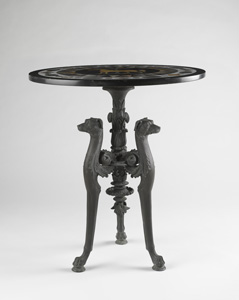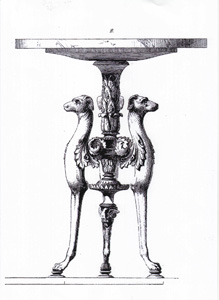 New Materials
New Materials
New Possibilities!
At the first encounter with our guéridon ,Greyhounds', Berlin circa 1846, we thought to have found a sculpture made of patinated bronze, but the haptics refers to a nearly forgotten, high level craft in Prussia: The “Berlin Cast Zinc” would have not reached its reputation without the support of trade and industry in Prussia.
With its innovative artistic style one associates primarily the name of the founder Moritz Geiss (1805-1875). Between 1841 and 1852 Geiss published a series of 21 catalogues entitled: "Zinkguß-Ornamente nach Zeichnungen von Schinkel, Stüler, Persius etc.", making his production widely known. In 1834 he developed the 'Geißsche Verfahren', a technical process, that made it possible to use zinc as a material for the hollow casting to produce sculptures. Casts of antiquities were very popular in Prussia as well as abroad, especially since Geiss understood to patinate the cast zinc to give it the appearance of bronze. Moreover he manufactured sculptures and ornaments designed by famous artists and architects of his time like Kiss, Persius, Rauch , Schadow, Schinkel, Stiller, or Strack. The first furniture made of zinc can be dated to the year 1837.
The guéridon 'Greyhounds' is a key example of the innovative zinc casting at the vanguard of technical development at the time. His tripod with marble top follows typologically widespread Roman models in bronze and stone, as known from excavations in Pompeii and Herculaneum. But this table is not only a copy of an ancient find, the design drawing for it made by the architect Johann Heinrich Strack (see illustration) and its implementation by Geiss is a fashionable and independant creation in the new material.
 We discovered this table recently in an old private collection in France and until now it is the only known example, that follows exactly the design by Strack. No evidence of an existing table could be found in the the castles and palaces of the Hohenzollern family or on historical photographs. The realisation in cast zinc is a highly sophisticated aesthetic solution, because it is constructed without the need of any stretchers connecting the feet.
We discovered this table recently in an old private collection in France and until now it is the only known example, that follows exactly the design by Strack. No evidence of an existing table could be found in the the castles and palaces of the Hohenzollern family or on historical photographs. The realisation in cast zinc is a highly sophisticated aesthetic solution, because it is constructed without the need of any stretchers connecting the feet.
Johann Heinrich Strack (Bückeburg 1805-1880 Berlin) studied at the Berlin Academy of Architecture. Between 1825 and 1832 he worked in the studio of Karl Friedrich Schinkel for the interior of the accommodation for the Crown Prince Friedrich Wilhelm at Berlin Palace, and from 1827 to 1832 he was under Friedrich August Stiller for the reconstruction of the palace of Prince Carl.
In 1841 he was appointed professor at the Prussian Academy of Art, where he had been a teacher since 1839. He worked mainly as a court achitect for the Pince William of Prussia (later Emperor), who commissioned him to complete the Castle Babelsberg, designed and built by Schinkel. From 1842 he served in the Hofbauamt and in 1850 he joined the Baudeputation and Hofbaurat. In 1854 he was appointed a professor at the Berlin Bauakademie and in 1862 he carried out excavations in Athens with Ernst Curtius and Karl Bötticher. In 1876 Wilhelm I made Strack "Kaiser's architect", which also marked his transition to retirement.
Stracks' design reflects for most of his life on the fashionable 'Etruscan' and 'Pompeian style', much appreciated by the Prussian nobility at the time. His style is characterised as an uncompromising adherence to classicism, which makes him one of the most interesting artists among the successors of Schinkel. He was also a sensitive colourist and interior decorator, and published several works including a book of architectural details (1858) and a study of Greek theatres (1843).
The guéridon was sold in March 2012 to the international art trade.